Preface
As a smaller nation militarily-speaking, the Italian tech tree has never been particularly big as there’s only so much native equipment + modified imports that can be implemented in game. To resolve such issues, War Thunder has often added subtrees of even smaller nations that had historically been politically, militarily or culturally connected to the tech tree nation, for example, the introduction of a Finnish line in the Swedish Air and Ground trees, and the upcoming addition of the Hungarian line in the Italian ground tree. With this in mind, I suggest the implementation of a Romanian line in the Italian fixed-wing aircraft tree, to help bolster the numbers in the Italian tree, add unique vehicles from a smaller nation that may not be independently represented in War Thunder, and provide a larger breadth of capabilities and gameplay to the Italian tech tree.
Why Romania?
Romania is a nation that enjoyed many political and military ties with Italy in the interwar period and WW2 especially. Indeed, this is already reflected in game, as aircraft from Romania already make an appearance in the Italian tree, such as the IAR-81C and SM.79B - just like how Hungarian tanks were present in the Italian ground tree as premiums until now. In addition, in the Cold War, Romania can provide a unique Eastern-Bloc twist to the Italian tree, as the Romanian Airforce employed Soviet equipment as well as unique designs built with Soviet technologies.
The Romanian Subtree
Potential Additions + Their place in the Italian TT
Breakdown of Suggested Aircraft
IAR P.11F
Fighter
Rank I
B.R.: 1.7
The PZL P.11 was the mainstay of the Polish Air Force in the interwar era and run up to WW2. The single engine, monoplane gullwing was innovative back when it was introduced in 1934. Designed by Warsaw-based manufacturer PZL, the aircraft was also exported to other nations, such as Romania. The Romanian Air Force would operate two variants of the airplane: the P.11B, built by PZL and exported to Romania, and the P.11F, license built by IAR in Romania. In addition, after the fall of Poland, Polish P.11’s were acquired by Romania due to Polish pilots landing in Romania, to escape to France and Britain and continue their fight there. The P.11F was powered by the Romanian-built IAR 9Krse 9-cylinder radial motor, a license build of the French Gnome-Rhone Mistral outputting 595 hp. For armament, the P.11F was outfitted with a quartet of 7.92 mm FN Browning machine guns. In Romanian service, the P.11F only saw action in defensive patrols of Romania following the initiation of hostility with the USSR during Operation Barbarossa in summer 1941.
Performance Specifications
• Length: 7.55 m
• Wingspan: 10.72 m
• Height: 2.85 m
• Wing Area: 17.9 sq. m
• Empty Weight: 1,147 kg
• Gross Weight: 1,630 kg
• Engine: IAR 9Krse Mistral (595 hp)
• Prop: 2-bladed Szomanski fixed-pitch wooden
• Top Speed: 300 km/h @ sea level
• Stall Speed: 98 km/h
• Range: 700 km
• Ceiling: 8000 m
• Climb Rate: 5,000 m in 6 min.
• Wing Loading: 91.1 kg/sq. m
Weaponry
• ×4 FN Browning 7.92 mm MG
Image: P.11F
Source: PZL P.11 - fighter
IAR P.24E
Fighter
Rank I
B.R.: 2.0
Developed off the successful PZL P.11, the P.24 was an export-focused design of the P.11, sold primarily to the customers of the P.11, such as, in this case, Romania. The P.11’s domestic (Polish) models were primarily powered by the British Bristol Mercury radial engine, which, due to a license agreement, banned its export from Poland to other nations. As such, exported P.11’s were powered by the French Gnome-Rhone Mistral, a trait which was carried on to all models of the P.24. This includes the Romanian license built model, the IAR P.24E. The P.24 was a general evolution of the P.11’s design, retaining the monoplane gullwing design, and incorporating new, more powerful engine and armaments. Now powered by a 14-cylinder Mistral Major, the engine output almost twice the power. In addition, the firing power of the airplane was now bolstered by the incorporation of a pair of 20 mm Oerlikon FF cannons. In Romanian service, similarly to its P.11 predecessor, the airplane was typically held back in the conflict between Romania and the USSR, as it had already been judged outmatched by some of the earlier WW2 combat aircraft fielded by Italy and the Soviet Union. 37 VVS bombers were shot down in the defense of Bucharest and Ploiesti. The type was relegated first to ground attack, then, by 1942, training.
Performance Specifications
• Length: 7.55 m
• Wingspan: 10.72 m
• Height: 2.69 m
• Wing Area: 17.9 sq. m
• Empty Weight: 1,327 kg
• Gross Weight: 1,900 kg
• Engine: IAR K14-I C32 (930 hp)
• Prop: 2-bladed
• Top Speed: 340 km/h @ sea level
• Stall Speed: 98 km/h
• Range: 700 km
• Ceiling: 9000 m
• Climb Rate: 11 m/s
• Wing Loading: 105.6 kg/sq. m
Weaponry
• ×2 FN Browning 7.92 mm MG
• ×2 Oerlikon FF 20 mm cannon
• ×2 50 kg bombs
Image: P.24E
Source: http://all-aero.com/index.php/contactus/54-planes-p-q-e-r-s/8507-pzl-p24
IAR-80A
Fighter
Rank: II
B.R.: 2.0
After many lessons learned by IAR from the license production of the PZL P.11 and P.24, the IAR firm set out to build its first fully modern, fully native fighter design. This design would set out to take the strengths of the P.24 design, while overhauling it and modernizing it for the conditions of the 1940’s. The engine, its mounting and cowling were preserved from the P.24, as was the tail structure and rear fuselage. An all new straight, low mounted wing was designed, as was an enclosed cockpit. Finally, a wide retractable landing gear was designed to maximize aerodynamics. The first test of the design was conducted in April of 1939, mere months before the start of WW2 in Europe. When compared with Germany’s primary export fighter, the He 112 B, the IAR-80 showed superior performance, and as such the construction of the new plane was prioritized over the import of the German design. The IAR-80 was to be mounted with a complement of six FN Browning 7.92 mm machine guns, however, due to the conquest of Belgium by Germany in 1940, the import of the guns were halted, and until Romania entered the Axis sphere via a fascist coup, the limited supply of guns limited the shipment of fighters. Once Romania joined the Axis war effort, FN gun shipments resumed. With Romania now on the Axis side in mid-1941, the IAR-80A, which improved on the initial IAR-80 design through lessons learned by the opening stages of aerial warfare across Europe, was now fully prepared, with a more powerful IAR K14-IV 1000A engine outputting 1,025 hp, all six machine guns, and armor protecting the pilot.
Performance Specifications
• Length: 8.9 m
• Wingspan: 10.5 m
• Wing Area: 15.97 sq. m
• Empty Weight: 2,080 kg
• Gross Weight: 2,685 kg
• Engine: IAR K14-IV 1000A (1,025 hp)
• Prop: 3-bladed
• Top Speed: 500 km/h @ 4,500 m
• Range: 730 km
• Ceiling: 10,500 m
• Climb Rate: 6000 m in 7.3 min
Weaponry
• ×6 FN Browning 7.92 mm MG
Image: IAR-80A

Sources:
- IAR-80 Fighter
- The IAR-80/81; Romanian Rumbler - Forgotten Aircraft - Military Matters
- The IAR 80: Romania's Home Grown Fighter
IAR-81A
Fighter-Bomber
Rank II
B.R.: 2.3
From the successes of the IAR-80 in the opening stage of Romania’s involvement in WW2 on the Axis side, the need for a dive bomber became urgent for the Romanian air force following the limited importation of the German Ju-87 dive bomber. As such, the IAR-80A was chosen to be augmented into a more multipurpose airplane, capable of carrying bombs for the dive-bombing mission. This resulted in the IAR-81. Following the introduction of the type, it also became apparent that the six light machine guns the IAR-80A was equipped with were not sufficient for combat. As such, a pair of 7.92 mm machine guns were replaced with heavier 13.2 mm guns. This created the IAR-80B in its pure fighter form, and the IAR-81A in the fighter-bomber form. In addition, the IAR-80B/IAR-81A was given a lengthened wingspan of 11 meters.
Performance Specifications
• Length: 8.9 m
• Wingspan: 11.0 m
• Wing Area: 16.50 sq. m
• Empty Weight: 2,140 kg
• Gross Weight: 3,070 kg
• Engine: IAR K14-IV 1000A (1,025 hp)
• Prop: 3-bladed
• Top Speed: 470 km/h @ 4,500 m
• Range: 1,030 km
• Ceiling: 10,000 m
• Climb Rate: 6000 m in 9.1 min
Weaponry
• ×4 FN Browning 7.92 mm MG
• ×2 FN Browning 13.2 mm MG
• ×2 50 kg bombs (underwing)
• ×1 250 kg bomb (centerline)
Image: IAR-81A

Sources:
- IAR-80 Fighter
- The IAR-80/81; Romanian Rumbler - Forgotten Aircraft - Military Matters
- The IAR 80: Romania's Home Grown Fighter
IAR-81B
Fighter-Bomber
Rank II
B.R.: 2.3
After the refitting of the 13.2 mm machine guns to the IAR-80A/81 to form the IAR-80B/81A, it was quickly found that firepower remained a critical weakness in the airplane, as the heavy machine guns, often taken out of turret emplacements of SM.79’s imported from Italy, did not offer enough of a punch. It was thus decided to equip the aircraft with 20 mm cannons from Germany, chiefly the MG-FF/M. This cannon was the easiest choice as it was similar to the familiar Oerlikon FF, but fired the far more devastating Minengeschoss 20 mm round, and was readily available as surplus from Germany, as they switched to the new MG 151/20. In late 1942, these modifications, along with the introduction of self-sealing fuel tanks resulted in the IAR-80C/81B, which continued the fight against the Soviet Union.
Performance Specifications
• Length: 8.9 m
• Wingspan: 11.0 m
• Wing Area: 16.50 sq. m
• Empty Weight: 2,140 kg
• Gross Weight: 3,070 kg
• Engine: IAR K14-IV 1000A (1,025 hp)
• Prop: 3-bladed
• Top Speed: 470 km/h @ 4,500 m
• Range: 1,030 km
• Ceiling: 10,000 m
• Climb Rate: 6000 m in 9.1 min
Weaponry
• ×4 FN Browning 7.92 mm MG
• ×2 MG-FF/M 20 mm cannon
• ×2 50 kg bombs (underwing)
• ×1 250 kg bomb (centerline)
Image: IAR-81B

Sources:
- IAR-80 Fighter
- The IAR-80/81; Romanian Rumbler - Forgotten Aircraft - Military Matters
- The IAR 80: Romania's Home Grown Fighter
IAR-81M
Fighter-Bomber
Rank III
B.R.: 2.7
With the Axis now on the backfoot in late 1942/early 1943, the Romanian Air Force needed a stopgap solution prior to the introduction of imported and license-built Bf 109 G’s from Germany. While the IAR-80 design reached its zenith with the definitive IAR-81C, Romania could not depend on the manufacture of this new plane and needed to bolster its numbers with fighters that could hold the line. As a result, the old stock of IAR-80/81’s were taken for upgrades to the IAR-81C standard, resulting in the IAR-80/81M. The primary difference between the IAR-80M/81M and the past IAR-80/81 variants they were based off was the armament - which was now fully standardized to four FN Browning 7.92 mm MG’s, and two MG 151/20 20 mm cannons. Performance was identical to whatever airframe the upgrade was based off of. Attempts were made to fit in the much more powerful BMW 801 radial engine, however, it was clear Germany would refuse to divert these much-needed engines from Fw 190 assembly lines.
Note: In-game, the IAR-81M would be near-identical to the IAR-81C
Image: IAR-81M
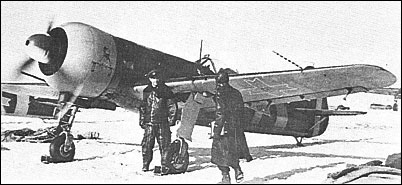
Sources:
- IAR-80 Fighter
- The IAR-80/81; Romanian Rumbler - Forgotten Aircraft - Military Matters
- The IAR 80: Romania's Home Grown Fighter
Bf 109 Ga-4
Fighter
Rank III
B.R.: 4.3
The Bf 109 Gustav was possibly the definitive model of the iconic German fighter. Built in enormous numbers, this model was also the most exported to Axis nations, flying under many flags in a multitude of sub-variants. The G-4 is a minor modification of the early family of Bf 109G’s. Incorporated changes over the G-2 include:
- FuG 16 VHF radio set and a different antenna mast
- Enlarged landing gear wheels: 660×160 mm + positive camber relative to landing-gear legs
- Tear-drop-shaped upper wing fairings to fit the newly enlarged landing gear
- Enlarged tail wheel: 350×135 mm + tail wheel became fixed
In all, the G-4 was identical to the G-2 in all performance and armament aspects, but included visual differences as a result to the listed modifications which made the type more visually similar to the subsequent G-6 model. The designation “Ga-4” differentiates it from the G-4 in that it was a model destined for export/foreign license build, with the a standing for auslander (foreign).
Note: In-game, the Bf 109 Ga-4 is functionally identical to the Bf 109 G-2
Images: Bf 109 Ga-4
Various Romanian Bf 109 camouflages
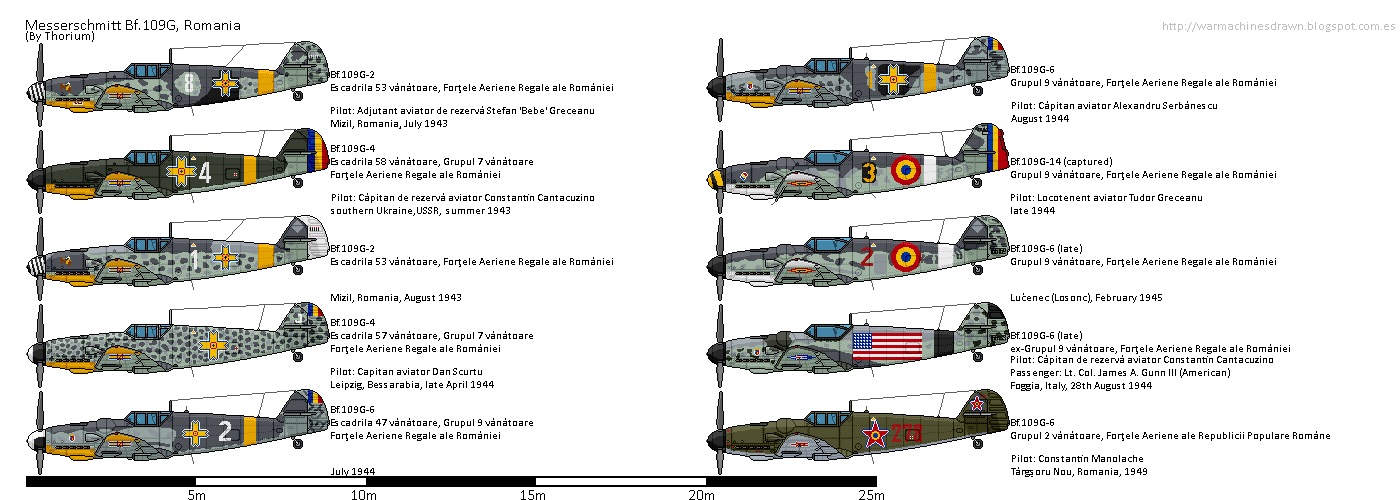
Bf 109 G-4, in German colors

Source: Romanian Air Force | Aircraft of World War II - WW2Aircraft.net Forums
Bf 109 Ga-6
Fighter
Rank IV
B.R.: 4.7
Building on the continued success of the Bf 109 G-series, the G-6 was designed for countering Allied bombing raids in Germany. Such an airplane also became important to Romania. Romania is one of the most oil-rich nations on the European continent, and as such acted as the Axis’s gas station. This made the Romania oil industry a priority target for Allied bombing raids, conducted by the USAAF. As a result, the same Bf 109 G-6 made to intercept these bombing raids in Germany was adopted rapidly by Romania, already an experienced operator in many Bf 109 variants… The designation “Ga-6” differentiates it from the G-6 in that it was a model destined for export/foreign license build, with the a standing for auslander (foreign).
Note: Identical to the Bf 109 G-6 already in-game
Image: Bf 109 Ga-6

Source: Romanian Air Force | Aircraft of World War II - WW2Aircraft.net Forums
Fw 190 F-8
Attacker
Rank IV Premium
B.R.: 5.0
The Fw 190 was built from the onset to be the heavier, multirole counterpart to the Bf 109’s purebred fighter pedigree. Able to carry more bombs from the get-go, the Fw 190 Freidrich would be the dedicated ground attack model of the “Butcher Bird”. Equipped with a multitude of armored plates, bombs, rockets and heavy cannons, the airplane was able to wreak havoc on ground troops, and escape fairly successfully thanks to its far more rapid design in comparison to conventional attackers like the Ju 87 G or Hs 129 B. The anti-fascist coup in Romania led to the nation switching sides from Axis to Allies in 1944, subsequently putting Romania in immediate state of war against Germany. This led to some unsuspecting Germans and their equipment being captured by the Romanians, including an Fw 190 F-8. A few models were pressed into Romanian service, before being seized by advancing Soviet troops.
Note: Identical to the Fw 190 F-8 already in-game
Image: Fw 190 F-8

Source: Focke Wulf Fw 190 in Romanian Service - Destination's Journey
La-9
Fighter
Rank IV
B.R.: 6.0
With the collapse of the Axis war effort, and an anti-fascist coup conducted in Romania in late 1944, Allied victory in Europe was achieved. With an American invasion from the west, and a Soviet one from the east, Europe became divided between a US-sphere and a Soviet-sphere, with Romania falling into the Soviet-sphere. With conflict immediately brewing between the USSR and the east versus the USA and the west, it became in the USSR’s interests to re-arm her client states, resulting in the new Air Force of the Army of the Romanian People’s Republic acquiring the latest Soviet piston-engined fighter, the La-9.
Note: Identical to the La-9 already in-game
Image: La-9
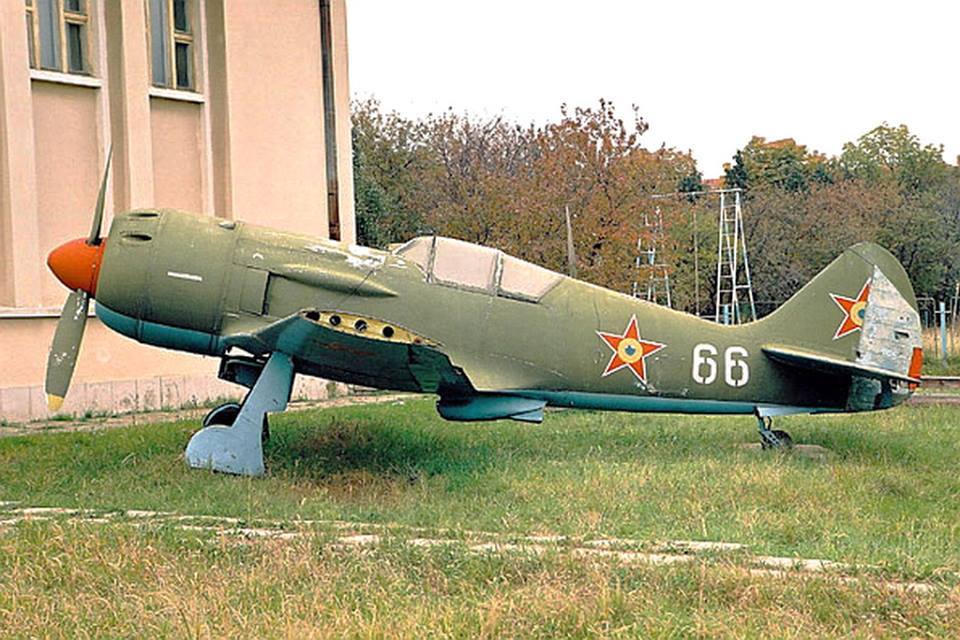
Source: Lavochkin La-9 (Fritz) Single-Seat Monoplane Fighter Aircraft
Il-28/H-5
Jet Bomber
Rank V
B.R.: 8.0
The Il-28 was a popular twin-engined light jet bomber in the services of a vast number of Soviet allied nations. Developed with the assistance of captured German jet technology, such as the German Ar 234 jet bomber, and equipped with the stolen copy of the British RR Nene jet engine, the Il-28 made its service debut in mid-1949. Successful in the USSR, the type would see widespread adoption across the Eastern Bloc, as well as license construction in Czechoslovakia and China. One such customer for the Il-28 was Romania, who purchased the bomber from both the USSR and China (Chinese license-built model: Harbin H-5). In Romania, the bomber was nicknamed Blandul Ben (Gentle Ben).
Note: Identical to the Il-28 already in-game
Image: Il-28

Source: Ilyushin Il-28 "Beagle"
Yak-23
Jet Fighter
Rank V
B.R.: 8.7
As the technology race between east and west warmed up in the late 1940’s, jet technology, which was once novel, proliferated among both American and Soviet designs, in part thanks to captured German technology and scientists. Nascent jet design in the Soviet Union consisted of re-engining existing prop fighters with newly acquired jet engines. One such example was the Yak-15/17 family, equipped with BMW 004 jet engines in place of the Yak-3’s VK105 piston engine. The concept, while fairly successful for the immediate post-war years, laid the groud for a true purpose built jet fighter: the Yak-23. Powered by the Klimov RD-500 jet engine, a stolen copy of the British RR Derwent V, this 1949 airplane never succeeded due to its dated straight-wing design in comparison to the cutting-edge MiG-15. The Yak-23 became relegated to training squadrons, and export to Eastern Bloc client-states, of which Romania was one. After the Yak-17, this was the second jet fighter to enter service in Romania. 62 were received from the USSR in 1951. The first interception mission carried out by the Romanian Air Force involved a Yak-23, scrambled from Ianca, intercepting a Soviet Il-28 which strayed in and out of Romania along the border.
Note: Identical to the Yak-23 already in-game
Image: Yak-23
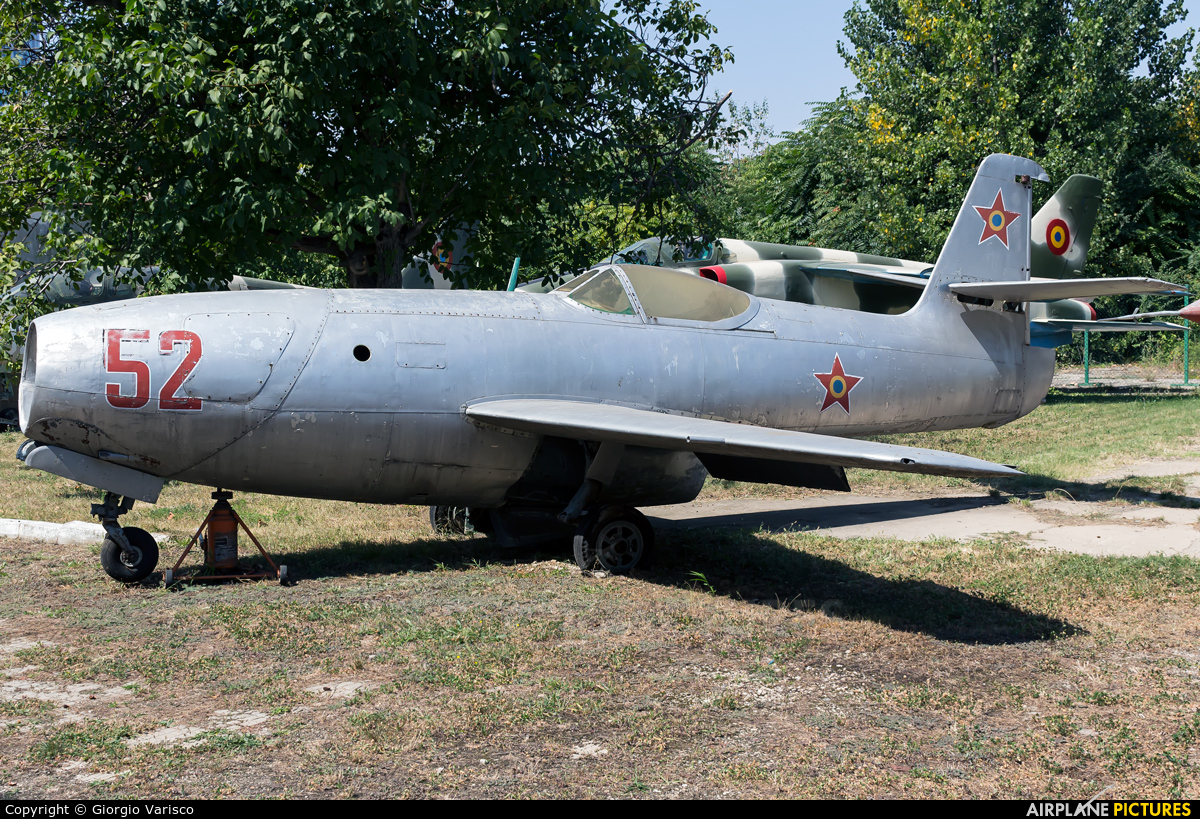
Sources:
- Yakovlev Yak-23 - fighter
- https://www.aviatiamagazin.com/headline/prima-misiune-de-interceptare-unei-tinte-reale-cadrul-fortelor-aeriene-romane/ (Translated by Google)
MiG-21RFMM
Jet Fighter
Rank VI
B.R.: 9.3
The MiG-21 is the most iconic and widely exported Eastern Bloc supersonic jet fighter design of the Cold War. As such, Romania, a member of the Warsaw Pact, was one of many to operate the type. The Romanian Air Force would take delivery of many versions of the MiG-21, such as the MiG-21PFM, from the Soviets in 1966. The MiG-21PFM was locally designated the MiG-21RFMM. It typically carried a ventral droptank, which could be swapped for a GP-9 gunpod equipped with a 23 mm GSh-23 cannon. For air-to-air, it could carry a pair of R-3S IR missiles (locally manufactured as “A-91”), and for air-to-ground, it carried a pair of bombs, ranging from 100, 250 or 500 kg, or a pair of rocket launcher blocks containing sixteen S-5M rockets each.
Note: Identical to the MiG-21PFM already in-game
Image: MiG-21RFMM
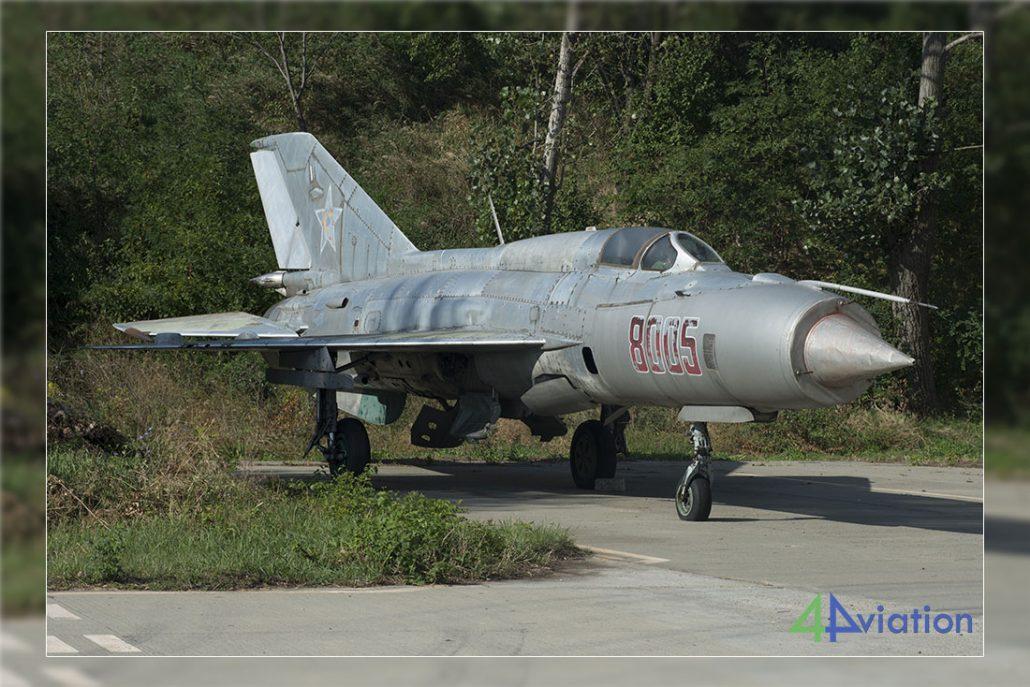
Source: MiG-21 RFMM - Aripi Argintii (Translated by Google)
IAR-93B Vultur
Jet Attacker
Rank VI
B.R.: 9.3-9.7
Approximately 30 years has passed since IAR had last designed its own unique front-line combat airplane, the IAR-80/81 series from 1939. In the early-1970s, Romania, in partnership with Yugoslavia, set out to produce their own transonic close air support (CAS) jet attacker. Both Romania and Yugoslavia had interested in maintaining a certain degree of independence from the Soviet Union in terms of military procurement, as Ceausescu had run rogue from the rest of Warsaw Pact in certain past cases, such as the then recent 1968 Czechoslovakia crisis, and Yugoslavia was not even member of the pact, due to its non-aligned position, alienated by Stalin in the post-war years. This Romanian-Yugoslav cooperation in the YuRom project resulted in the IAR-93 Vultur and SOKO J-22 Orao, lightweight twin-jet engined strike aircraft, first flown in October 10th, 1974 in Bacau, RO and Mostar, YU. Reminiscent of the successful Anglo-French SEPECAT Jaguar, the IAR-93 was built as a twin-engine, with a high shoulder mounted swept wing design. Three variants were ultimately built, the basic -A model, the upgraded -MB model, and the afterburning -B model. A bulk of the sensors and weaponry was sourced from the Soviet Union, as it would provide the aircraft commonality with existing stock and equipment that personnel are already familiar with. However, some weapons are sourced from the USA/NATO, and the engine, the British Armstrong-Siddely Viper, was license-built in Romania by Turbomecanica. 33 out of 86 IAR-93s were IAR-93B’s, which represents the peak of the design’s development. The IAR-93 was studied for further development in the late-1980s, especially in cooperation with Israel’s Elbit, however, all plans for further development collapsed due to the breakout of the Yugoslav Civil War. The IAR-93 was retired from Romanian service in 1998.
Performance Specifications
• Length: 14.85 m
• Wingspan: 9.62 m
• Height: 4.45 m
• Wing Area: 26 sq. m
• Empty Weight: 5,750 kg
• Max Takeoff Weight: 11200 kg
• Engine: ×2 Turbomecanica Viper 633-47
• Thrust (dry/burner): 17.8 kN ×2/ ×2 22.3 kN
• Top Speed: 1,100 km/h @ sea level
• Range: 1,337 km
• Ceiling: 13,600 m
• Climb Rate: 70 m/s
Sensors/Equipment
• IFF
Note: More information on the Romanian equipment would be appreciated
Comment: The J-22B in Yugoslav/Serbian service saw more modernization such as the use of locally derived RWR system and fitment of countermeasures. Those could be added to the IAR-93B.
Weaponry
• ×2 GSh-23 23 mm cannon
➢ 200 rounds per gun
• ×5 hardpoints
➢ ×1 centerline, ×2 per wing
• Total of 2,500 kg of suspended load
• ×2 air-to-air IR-guided missiles
➢ A-91 (R-3S)
➢ R-60
• Air-to-ground missiles
➢ ×2 A921 (Kh-23)
• Unguided Rockets
➢ LPR 57 launcher (×16 S-5 rockets)
➢ LPR 122 launcher (×4 S-24 rockets)
➢ PRN-80 launcher (×20 PRN-80 HEAT rockets)
• Free-fall Bombs
➢ ×12 100 kg, ×8 250 kg, ×4 500 kg
• Incendiary Bombs
➢ ×4 360 kg FLAB-350
Image: IAR-93B
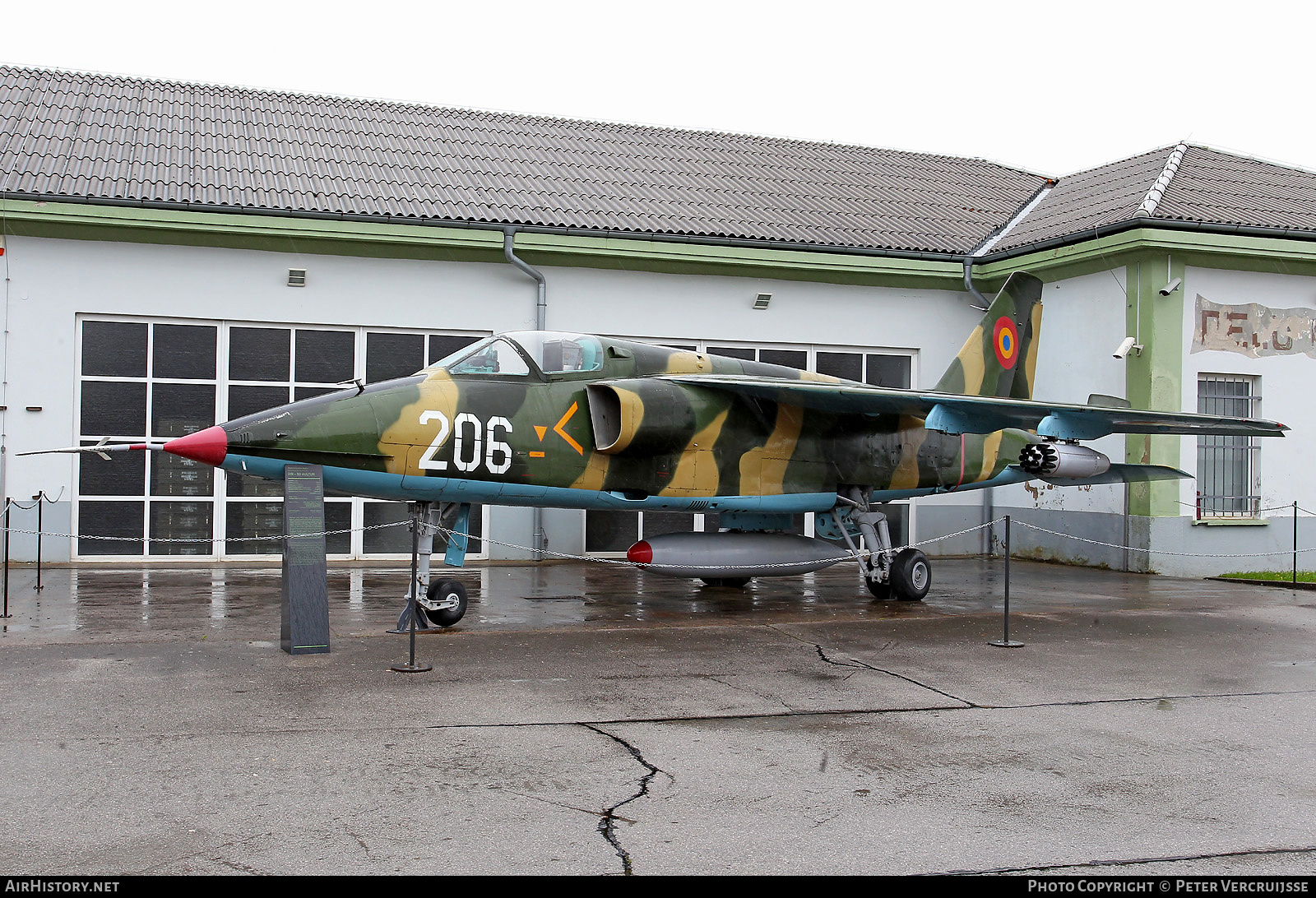
Source:
- IAR-93 - Aripi Argintii (Translated by Google)
- ORAO TECHNICAL DETAILS
- https://romarm.ro/wp-content/uploads/2021/05/84_-Datasheet-Romarm-PRN-80-AIR-TO-GROUND-ROCKET.pdf
SOKO J-22B Orao 2
Jet Attacker
Rank VI Premium
B.R.: 9.7-10.0
SOKO, Yugoslavia’s state-ran aircraft manufacturer, had already established itself in the country from the pre-war days as Ikarus. Throughout the Cold War, Yugoslavia found itself stuck in the middle between the East (USSR) and West (USA), as a Communist nation which has chosen to not-align itself with the USSR following major political fallout between Stalin and Tito. As a result, Yugoslavia, through SOKO, had to be quite self-reliant on military technology, including aircraft. Relations between Yugoslavia and the USSR much improved following Stalin’s death, but Yugoslavia commited to its non-aligned position. As such, SOKO would produce many original native Yugoslavian designs, responsible for unique aircraft such as the G-2 Galeb trainer, J-21 Jastreb attacker, G-4 Super Galeb trainer, and culminating with the J-22 Orao attacker. The J-22 Orao (Eagle) was the product of the join partnership with Romania’s IAR, named YuRom. This cooperative partnership helped both nation’s fledgling aircraft industries take on the daunting task of designing a unique , modern and capable frontline combat airplane. This resulted in the IAR-93 on Romania’s end, and on October 10th 1974, the SOKO J-22 Orao took off for its first flight in Mostar, SR BiH, Yugoslavia. Once in service, development of the J-22 followed a similar path to that of the IAR-93 in Romania, with upgrades to avionics and the installation of an afterburner progressively coming in. However, upon the general dissolution of the Eastern bloc in the late 1980’s, the YuRom partnership would be entirely lost as Yugoslavia collapsed into civil war. The Yugoslav wars would be the only conflict the J-22 would take part in, initially flying under the JNA (Yugoslav Army), before entering the inventories of two immediate Yugoslav successor states - Serbia & Montenegro, and Republika Srpska. In 2006, a decade after the end of the war in Bosnia, the R.S. J-22’s were put into service with the Air Defense of Bosnia, which has since retired them. In Serbia however, the J-22 remains in service.
Performance Specifications
• Length: 14.85 m
• Wingspan: 9.62 m
• Height: 4.45 m
• Wing Area: 26 sq. m
• Empty Weight: 5,750 kg
• Max Takeoff Weight: 11200 kg
• Engine: ×2 Orao Viper 633-47
• Thrust (dry/burner): 17.8 kN ×2/ ×2 22.3 kN
• Top Speed: 1,100 km/h @ sea level
• Range: 1,337 km
• Ceiling: 13,600 m
• Climb Rate: 70 m/s
Sensors/Equipment
• Iskra SO-1 RWR
• ×3 Chaff/Flare dispensers
• IFF
Comment: Additional information on the J-22B’s sensor systems and countermeasures would be helpful
Weaponry
• ×2 GSh-23 23 mm cannon
➢ 200 rounds per gun
• ×5 hardpoints
➢ ×1 centerline, ×2 per wing
• Total of 2,500 kg of suspended load
• ×2 air-to-air IR-guided missiles
➢ R-3S
➢ R-60
• ×2 Air-to-ground missiles
➢ Grom-1 (Kh-23)
➢ AGM-65
• Unguided Rockets
➢ LPR 57 launcher (×16 S-5 rockets)
➢ LPR 122 launcher (×4 S-24 rockets)
➢ PRN-80 launcher (×20 PRN-80 HEAT rockets)
• Free-fall Bombs
➢ ×12 Mk.81, ×8 Mk.82, ×4 Mk.83
• Incendiary Bombs
➢ ×4 360 kg FLAB-350
Comment: Additional information on the J-22B’s suspended weapons would be helpful
Image: J-22B

Sources:
- ORAO TECHNICAL DETAILS
- Soko J-22 Orao Light Attack and Reconnaissance Aircraft | MilitaryToday.com
- https://www.airforce-technology.com/projects/soko-j-22-orao-ground-attack-and-reconnaissance-aircraft/
- AVIOANE J-22 Orao (Eagle)
MiG-21MF
Jet Fighter
Rank VII
B.R.: 10.3
The MiG-21MF was a very important step in the MiG-21’s evolution. As aerial warfare continuously and rapidly evolved in the 1960’s in light of the Vietnam War and Arab-Israeli wars, the Mikoyan design bureau applied these lessons learned, both first and second-hand, to their iconic MiG-21. This lead to progressive improvements to the airplane, resulting in the MiG-21MF model, which rapidly superseded all preceding MiG-21 models in the arsenals of the Soviet Union and export customers, including Romania. The MiG-21MF combined improved avionics such as a capable Sapfir RP-21 search and track radar, a more powerful engine, a more aerodynamic fuselage, integration of a fixed cannon (GSh-23), five hardpoints, and a more diverse set of suspended weaponry, such as the 30G-capable R-60 IR missile, radar-guided SARH R-3R missile, and a multitude of bombs and rockets. The MiG-21MF was introduced to Romanian service in 1972, with an updated model, the MiG-21MF-75, introduced in 1975 to incorporate cockpit upgrades from the MiG-21bis.
Note: Identical to the MiG-21MF already in-game
Image: MiG-21MF

Source: MiG-21 MF/MF-75 - Aripi Argintii (Translated by Google)
IAR-99C Shoim
Jet Attacker
Rank VII Squadron
B.R.: 10.3-11.3
In the mid-1980’s, the Institute of Scientific and Technical Creation in Bucharest, in collaboration with IAR, built the IAR-99, an advanced jet trainer with light ground attack capability. The airplane is small and sleek, on the level of its contemporaries such as the Dassault-Dornier Alphajet, BAE Hawk, and MB.339, built to replace the Czechoslovak L-29 Delfin and L-39 Albatros trainers, classic mainstays trainers of Eastern bloc air forces. As a trainer, this aircraft is a dual-control tandem two-seater, with the student in the front, and instructor in the back. As a trainer, this plane contains no integral weaponry, but, with its five hardpoints, is able to carry gunpods, rockets, bombs and missiles. The Shoim (Hawk) is a modernized variant produced in 1996 with Elbit of Israel, whom were also working on the LanceR at the time, while the non-modernized version was retroactively renamed the “Standard”. The modernization introduced improved avionics, warning sensors, and introduced additional precision-guided weaponry of western origin.
Note: B.R. is highly dependent on if the IAR-99C comes equipped with advanced IR missiles (Python 3)
Comment: Two native Italian designs already exist for the niche of light strike/advanced trainer role in the Italian tree: the Aermacchi MB.339 and AMX A-11 Ghibli. As Italian aircraft, they deserve first priority in the Italian tree, relegating the IAR-99C to a secondary role in the tree such as Squadron or Premium plane.
Performance Specifications
• Length: 11 m
• Wingspan: 9.85 m
• Height: 3.99 m
• Wing Area: 18.71 sq. m
• Empty Weight: 3,336 kg
• Max Takeoff Weight: 5,495 kg
• Engine: ×1 Turbomecanica Viper 632-41M (17.8 kN)
• Top Speed: 8,50 km/h @ sea level
• Range: 352 km
• Ceiling: 12,900 m
• Climb Rate: 32 m/s
Sensors/Equipment
• RWR
• Countermeasures
• ×2 225 L drop tanks
• Laser targeting pod
➢ On centerline rack
Weaponry
• ×5 hardpoints
➢ ×1 centerline, ×2 per wing
➢ Max. 400 kg on centerline point
➢ Max. 250 kg on each wing point
• Gunpods:
➢ GSh-23 23 mm cannon in GP-9 gunpod on central mount (200 rounds)
➢ PKT 7.62 mm machine gun in wing-mounted gunpod (400 rounds)
• ×2 IR-Guided Air-to-Air Missiles:
➢ R-60MK
➢ R-550 Magic-II
➢ Python 3
• Free-Fall Bombs:
➢ Mk.82
➢ BE 50, BE 100, BEM 250
• Unguided Rockets:
➢ LPR-57 rocket pod (×16 S-5 rockets)
• Precision-Guided Bombs:
➢ Opher (IR-guided)
➢ GBU/54B JDAM (laser-guided)
Image: IAR-99C

Sources:
- IAR-99 - Aripi Argintii (Translated by Google)
- IAR-99 Soim Advanced Trainer | MilitaryToday.com
- https://www.airforce-technology.com/projects/iar_99c/
MiG-21 LanceR-C
Jet Fighter
Rank VIII
B.R.: 11.7
The MiG-21MF’s which Romania had obtained from the USSR in the early-1970’s would not be Romania’s final import from the USSR. In 1979, Romania obtained the variable-sweep MiG-23MF to keep the Air Force up to date. A decade later, in 1989, Romania would also obtain its first true 4th generation fighter, the MiG-29A, from the USSR. However, the very same year, the political situation in Romania shifted rapidly, as the communist dictatorship was violently overthrown, and Romania thrust out of the collapsing Warsaw Pact. Throughout the '90s, Romania would search for a solution to maintain and update their MiG-29A’s, including one MiG-29S received from Moldova in 1992 after the Soviet break-up. For the next ten years, Romania would struggle to upkeep its MiG-29’s as the dissolution of the USSR has caused chaos in the now-Russian air industry. In 2000, a plan to modernize and upgrade their MiG-29’s was enacted by Romania and Israeli company Elbit Systems, resulting in the MiG-29 Sniper, which was ultimately cancelled in 2003 by the retiring of all MiG-29’s in Romania. The retirement of the MiG-29, and the failed upkeep of the MiG-23, resulted in the MiG-21, an airplane designed for easy upkeep and with easily sourced spare parts, to be selected for upgrade by Elbit Systems. 110 airframes were selected, of the M, MF, and UB models, resulting in the adoption of the MiG-21 LanceR in 1998. Three models of the LanceR were built, the -A for attack, -B for training, and -C for air superiority. These aircraft were outfitted with a brand new sensor suite, the Israeli EL/M-2032 PD multimode radar (which resulted in a slightly longer nosecone), fully refurbished airframes and jet engines. A 490 or 800 L droptank can be equipped under the belly of the plane. Suspended weaponry includes a multitude of both NATO and Russian equipment, ranging from Mk.-series of American bombs, Soviet S-5 and S-24 unguided rockets, or a total of six air-to-air missiles, such as the French Matra Magic-2, the Soviet R-60M, or, a far more potent pair of modern dogfight missiles, the Russian R-73 or Israeli Python 3. The big Achille’s heel of the LanceR is the lack of BVR capability, as no radar-guided missiles can be launched from it. With the increasing relevance of BVR in modern combat, and the influx of F-16’s into Romania, the MiG-21 LanceR is now slated for retirement by 2024.
Performance Specifications
• Length: 14.1 m
• Wingspan: 7.2 m
• Empty Weight: 5,895 kg
• Gross Weight: 10,420 kg
• Engine: R-25-300 Afterburning turbojet
• Thrust (dry/burner/emergency.): 40.3 kN/69.6 kN/97.1 kN
Note: Performance is similar to MiG-21MF it is based on
Sensors/Equipment
• Elta EL/M-2032 Radar
➢ 222 km range
➢ X-band
➢ PD mode
➢ ACM mode
➢ TWS mode
➢ Vertical Scan
• Thales SPS-20V2 RWR
➢ 2-18 GHz Frequency
➢ 360° azimuth, ±45° elevation detection
➢ Continuous display of signal position
➢ Transmitter data table - can ID threat source type
• Plessey IFF (NATO-compliant)
• HMD
➢ Helmet guidance of radar dish and missile seeker
• ×2 MPMN-60 countermeasures dispensers
➢ Mounted bottom-rear, left and right
➢ ×30 chaff or ×15 flares per dispenser
• Rafael LITENING laser designator pod
• Voice Warning System
➢ In Romanian (Female voice)
Weaponry
• ×1 GSh-23 23 mm cannon
• ×7 suspended weapons hardpoints
➢ ×1 centerline, ×3 per wing
• Up to ×6 air-to-air IR-guided missiles:
➢ R-60MK
➢ R-550 Magic-II
➢ R-73
➢ Python 3
• Free-fall bombs:
➢ Mk.82, Mk.83
➢ FAB-100, FAB-250, FAB-500
• Unguided rockets:
➢ S-5
➢ S-24
Image: MiG-21 LanceR-C
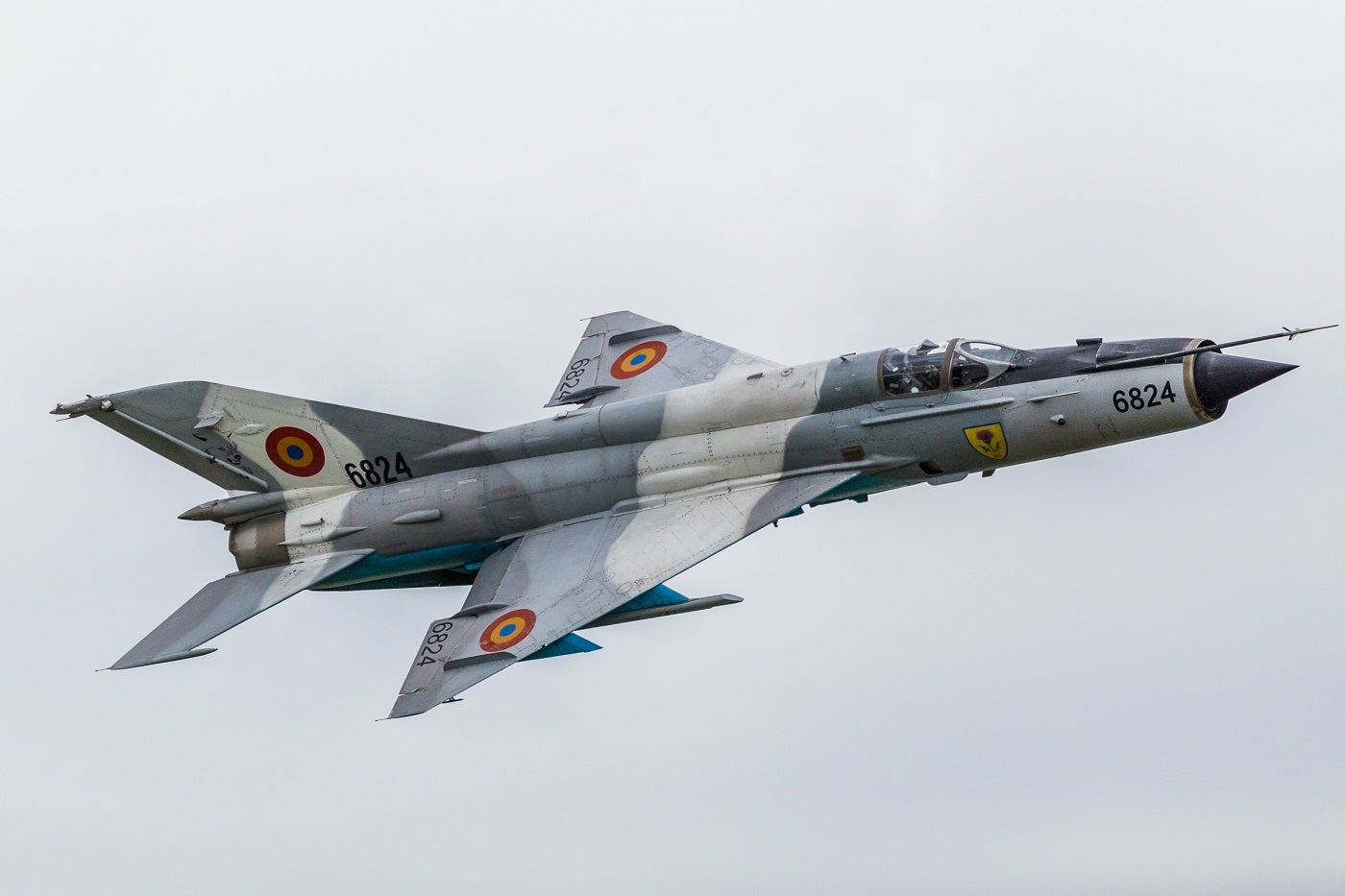
Sources:
- MiG-21 LanceR C - Aripi Argintii (Translated by Google)
- MiG-21 LanceR: Forged By the Soviets, Now Flying for NATO - autoevolution
- cmano-db.com
- https://www.iai.co.il/p/elm-2032
- https://www.4aviation.nl/wp-content/uploads/2016/12/Romania-jan16-Pacific-Wings-Patrick-Roegies.pdf
- MiG 21 Lancer | PDF | Avionics | Military Technology
- Romanian Air Force: the Transylvanian MiG 21 Lancer - Aviation Report - ENG
Further feedback is always appreciated!



















